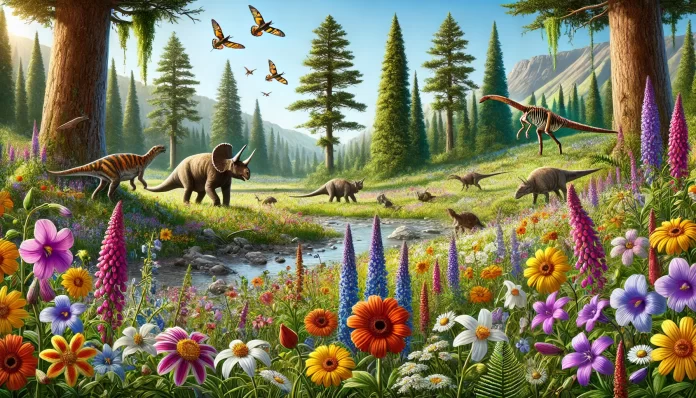Chapter 3: The Dawn of Flowers
By the time flowering plants arrived on Earth, the stage was already teeming with life. Towering forests of gymnosperms, ferns, and cycads dominated the landscape, and dinosaurs roamed beneath their canopy. But something transformative was about to bloom—literally. Around 130 million years ago, during the Cretaceous Period, flowering plants, or angiosperms, appeared, changing ecosystems forever.
The First Flowers
The earliest flowering plants were modest, simple structures compared to the showy blossoms we know today. Fossil evidence points to species like Archaefructus, a water-dwelling plant that likely had small, inconspicuous flowers. These early angiosperms evolved in niche environments, competing with gymnosperms, which relied on the wind for pollination.
What set flowering plants apart was their ability to form a partnership with animals. Flowers developed bright colors, alluring scents, and sweet nectar to attract pollinators like insects, birds, and even small mammals. This mutualistic relationship allowed angiosperms to spread quickly and diversify.
Pollination Partnerships
The evolution of flowers revolutionized reproduction. Unlike gymnosperms, which scattered their pollen randomly via the wind, flowering plants used animals to deliver pollen directly to other flowers. This precision made reproduction more efficient and opened up new ecological niches. Key developments included:
- Color and Patterns: Bright petals and UV patterns guided pollinators to nectar and pollen.
- Scents: Flowers evolved fragrances to attract specific pollinators, such as bees, beetles, or moths.
- Shapes: Tubular flowers catered to long-tongued pollinators like butterflies, while open flowers suited generalists like flies.
This partnership with pollinators created a rapid co-evolutionary arms race: as flowers became more specialized, so did their pollinators. This interaction led to a stunning variety of flower forms and colors, many of which persist today.
Seed Dispersal: The Fruit Revolution
Another angiosperm innovation was the development of fruits. Unlike gymnosperms, which relied on wind or water to spread seeds, flowering plants encased their seeds in fleshy, nutrient-rich coverings. Animals that ate the fruit helped distribute seeds far and wide, often fertilizing them in the process.
Fruits varied greatly to target specific dispersers:
- Bright, juicy fruits appealed to birds.
- Hard-shelled nuts attracted mammals like squirrels.
- Floating seeds, like coconuts, traveled via water.
This diversification in seed dispersal methods gave angiosperms an edge, allowing them to colonize nearly every corner of the planet.
A Global Takeover
By the end of the Cretaceous Period, flowering plants had become a dominant force in ecosystems. They diversified into trees, shrubs, herbs, and grasses, outcompeting gymnosperms in many environments. When the asteroid impact 66 million years ago ended the reign of the dinosaurs, flowering plants were among the survivors, ready to thrive in the new world.
The Age of Flowers
The success of angiosperms reshaped Earth’s biosphere. They created rich, diverse habitats like tropical rainforests and grasslands. These ecosystems supported new waves of animal evolution, from pollinators like bees and butterflies to herbivores like deer and elephants.
Today, flowering plants make up more than 90% of all plant species. From the tiniest wildflowers to towering oaks, they sustain life on Earth, providing food, oxygen, and shelter.
The arrival of flowers was a turning point in Earth’s history, bringing beauty, biodiversity, and abundance. But the story of plants doesn’t end here. The next chapter delves into how humans and plants forged a unique and enduring relationship.




